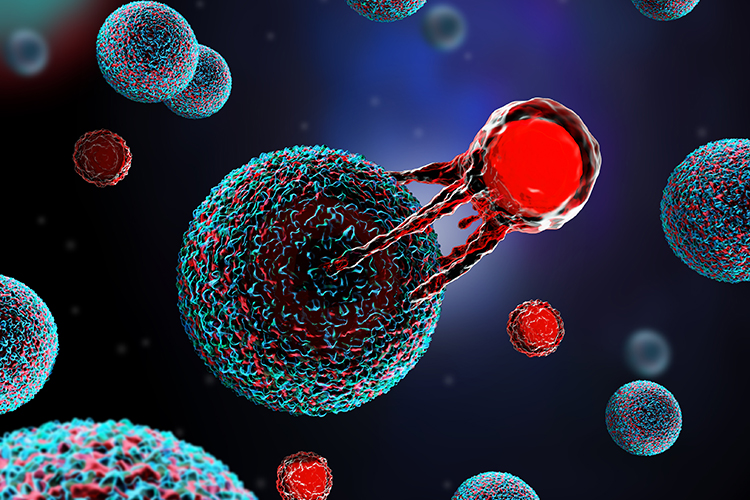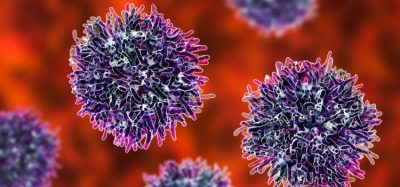Explaining uveal melanoma’s resistance to conventional immunotherapies
Posted: 17 April 2024 | Drug Target Review | No comments yet
Researchers have developed a new tool called ‘Uveal Melanoma Immunogenic Score’ to predict which patients will respond to adoptive therapy.


3d illustration of a T cell attacking a cancer cell
Scientists at the University of Pittsburgh have elucidated why metastatic uveal melanoma, a rare and aggressive cancer, is resistant to conventional immunotherapies, as well as how adoptive therapy can successfully treat it. They have also explained the development of a new clinical tool that predicts which patients will respond to adoptive therapy. The work, supported by UPMC Enterprises, will aid the improvement of personalised therapies.
Senior author Dr Udai Kammula, associate professor of surgery at Pitt and director of the Solid Tumour Cell Therapy Program at UPMC Hillman Cancer Center, commented: “The dogma was that uveal melanoma is a ‘cold’ cancer, meaning that T cells can’t get into these tumours…We show that T cells are in fact infiltrating metastases and they’re getting activated, but they’re just sitting there in a dormant state because something in the tumour is suppressing them. Adoptive therapy allows us to rescue these cells from the suppressive tumour microenvironment and successfully treat some patients.”
Originating in the uveal tract of the eye, uveal melanoma tends to aggressively spread throughout the body, often to the liver. When metastasis occurs, treatment becomes difficult and the prognosis for patients is almost always very poor. “Cutaneous melanoma, which affects the skin, is the poster child of immunotherapy. It responds incredibly well to immune checkpoint inhibitor drugs,” said Dr Kammula. “None of these conventional immunotherapies work for uveal melanoma, but we hadn’t known why — until now.”
Dr Kammula and his team used adoptive therapy in a previous Lancet Oncology study to surgically extract metastatic tumours from 19 uveal melanoma patients and grow T cells from these tumours in the laboratory. When they infused the cells back into the patients, 35 percent of patients had either partial or complete regression of their cancer. This provided evidence against the assumption that tumour-infiltrating lymphocytes (TILs) are not found in uveal melanoma. However, why immune checkpoint inhibitors are ineffective in treating this disease remained unknown.
In the new study, the researchers analysed 100 metastases from 84 patients and discovered that over half of these tumours were full of T cells. They then performed single cell RNA sequencing to measure gene expression in almost 100,000 cells from six metastases. The TILs in some of these tumours were activated and capable of attacking tumour cells in a dish, but they were not proliferating to high numbers in the tumour.
“We found that TILs from metastatic uveal melanoma have the potential to attack the tumour, but something in the tumour microenvironment is shutting them down, so they’re in a dormant, or quiescent, state,” explained Dr Kammula. “By liberating these cells from the suppressive environment and growing them in the lab, we can rescue their tumour-fighting capacity when infused back into the patient.”
TIL therapy does not work for everyone, as the researchers found in their earlier study, so Dr Kammula and lead author Dr Shravan Leonard Murali, a post-doctoral fellow in the lab, developed a clinical tool called Uveal Melanoma Immunogenic Score (UMIS). This is a holistic measure of the tumour that reflects the activity of over 2,000 genes expressed by tumour cells, immune cells and other cells that form the tumour microenvironment. Across 100 metastases, UMIS ranged from 0.114 to 0.347, with higher values indicating tumours with more potent TILs.
The researchers identified patients with higher UMIS scores had better tumour regression, suggesting that this biomarker could predict which patients are likely to respond to adoptive therapy. Furthermore, patients with metastases scoring above 0.246 had greatly improved progression-free survival and overall survival than those with UMIS below this cutoff.
“If a patient’s UMIS level is below this threshold, we think that adoptive therapy is not appropriate. Using a biopsy to calculate a patient’s UMIS could help avoid futile therapies and unnecessarily subjecting patients to invasive operations,” stated Dr Kammula. “But the immune system is not static. UMIS offers a window into the tumour that could also help us find the optimal time to treat a patient with adoptive therapy, like picking a fruit when it’s at its ripest.”
Currently, Dr Kammula is evaluating the score prospectively in an ongoing TIL therapy clinical trial at Pitt for patients with metastatic uveal melanoma. Also, the team are taking these learnings to tackle other difficult-to-treat tumours such as pancreatic cancer, developing a pan-cancer version of UMIS that will predict how well a patient with any type of cancer is likely to respond to adoptive therapy.
This study was published in Nature Communications.
Related topics
Cancer research, Immunotherapy, Personalised Medicine, Sequencing, T cells
Related conditions
Cancer Research, Pancreatic cancer, Uveal melanoma
Related organisations
University of Pittsburgh








